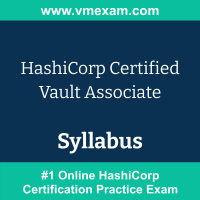 The HashiCorp Vault Associate exam preparation guide is designed to provide candidates with necessary information about the Vault Associate exam. It includes exam summary, sample questions, practice test, objectives and ways to interpret the exam objectives to enable candidates to assess the types of questions-answers that may be asked during the HashiCorp Certified - Vault Associate exam.
The HashiCorp Vault Associate exam preparation guide is designed to provide candidates with necessary information about the Vault Associate exam. It includes exam summary, sample questions, practice test, objectives and ways to interpret the exam objectives to enable candidates to assess the types of questions-answers that may be asked during the HashiCorp Certified - Vault Associate exam.
It is recommended for all the candidates to refer the Vault Associate objectives and sample questions provided in this preparation guide. The HashiCorp Vault Associate certification is mainly targeted to the candidates who want to build their career in Security Automation domain and demonstrate their expertise. We suggest you to use practice exam listed in this cert guide to get used to with exam environment and identify the knowledge areas where you need more work prior to taking the actual HashiCorp Certified Vault Associate exam.
HashiCorp Vault Associate Exam Summary:
|
Exam Name
|
HashiCorp Certified Vault Associate |
| Exam Code | Vault Associate |
| Exam Price | $70.5 USD |
| Duration | 60 minutes |
| Number of Questions | 57 |
| Passing Score | Pass / Fail (Approx 70%) |
| Recommended Training / Books | Prepare for the exam |
| Schedule Exam | Cloud Engineer Certification Exam Portal |
| Sample Questions | HashiCorp Vault Associate Sample Questions |
| Recommended Practice | HashiCorp Certified - Vault Associate Practice Test |
HashiCorp Vault Associate Syllabus:
| Section | Objectives |
|---|---|
| Authentication methods |
- Define the purpose of authentication methods - Choose an authentication method based on use case - Explain the difference between human vs. system authentication methods - Define the purpose of identities and groups - Authenticate to Vault using the API, CLI, and UI - Configure authentication methods using the API, CLI, and UI |
| Vault policies |
- Explain the value of Vault policies - Describe Vault policy syntax: path - Describe Vault policy syntax: capabilities - Choose a Vault policy based on requirements - Configure Vault policies using the UI and CLI |
| Vault tokens |
- Choose between service and batch tokens based on use case - Describe root token uses and lifecycle - Explain the purpose of token accessors - Explain the impact of time-to-live - Explain orphaned tokens - Describe how to create tokens based on need |
| Vault leases |
- Explain the purpose of a lease ID - Describe how to renew leases - Describe how to revoke leases |
| Secrets engines |
- Choose a secrets engine based on use case - Compare and contrast dynamic secrets vs. static secrets, and know their use cases - Describe the uses of transit secrets engine - Describe the purpose of secrets engines - Describe the use of response wrapping - Explain the value of short-lived, dynamically generated secrets - Enable secrets engines using the CLI, API*, and UI - Access Vault secrets using the CLI, API, and UI |
| Encryption as a service |
- Encrypt and decrypt secrets - Rotate the encryption key |
| Vault architecture fundamentals |
- Describe how Vault encrypts data - Explain how to seal and unseal Vault - Configure environment variables |
| Vault deployment architecture |
- Explain cluster strategy for self-managed and HashiCorp-managed Vault clusters - Explain the uses of storage backends - Explain the uses of Shamir secret sharing and unsealing - Explain the uses of disaster recovery and performance replication - Differentiate between self-managed and HashiCorp-managed Vault clusters |
| Access management architecture |
- Describe the Vault Agent - Describe the Vault Secrets Operator |
